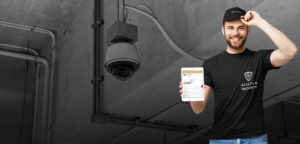Phoenix CCTV for Workplace Safety and Compliance
By Christian Dorau, Director, ADT Security
CCTV for Workplace Safety and Compliance –
Phoenix
Many people may think of CCTV cameras primarily as a security solution, but the benefits can be much broader. Organisations are increasingly recognising the value of surveillance cameras to help address workplace compliance and work, health and safety (WHS) policies.
WHS legislation states that employers and self-employed persons are to ensure the health and safety of all people in their workplaces. According to WorkCover NSW, the total direct costs due to slips, trips and falls in NSW alone is approximately $110 million. The laws in this regard can vary for different industries, but with the average cost of a workers compensation claim being approximately $18,900, potential litigation costs can have a major impact on a business. Having camera footage on hand to verify incidents or check an employee was following company policy and safety procedures can be a valuable resource, particularly for workers operating in hazardous environments or working alone in remote areas.
While CCTV cameras can be a vital resource for monitoring staff safety and compliance, companies must also consider the CCTV Code of Ethics. As CCTV becomes more common in the workplace, before installing a CCTV system, businesses must consider the ethical use of cameras to ensure they comply with Australian privacy laws. The law requires employers using CCTV cameras to inform staff that the cameras are in use and explain the reasons why the cameras are in place. CCTV cameras should not to be installed purely for the sake of observing staff – there must be justification for the presence of cameras, for example, monitoring WHS policies, overseeing the operation of machinery to help avoid the risk of injury or watching out for lone workers who may be located in isolated or remote areas.
It is a company’s responsibility to ensure all staff members understand the risks and hazards in their workplace environment and know how to manage them. It is also important for a company to consult on and communicate their surveillance policy and procedures so that employees fully understand how the CCTV footage is being used. If installing surveillance for the first time, consider involving staff in the initial stages of installation to ensure they feel a part of the process and understand the reasons why a monitoring system is being installed. Signage must also be clearly visible in and around the areas where cameras are present.
Considerations for installing CCTV cameras in the workplace
Before installing any surveillance system in the workplace, firstly identify what issues are to be addressed. This determines the type of CCTV system required, ensuring the right level of image quality for purpose. For instance, are finer details such as facial recognition or vehicle number plates important? This is where a professional security expert can help. A professional security consultant will assess the workplace environment and provide advice on things that a business owner can easily overlook such as the level of lighting and the positioning of the cameras.
The types of video surveillance that can help business address WHS and compliance may include:
- Security cameras: A full line of closed circuit television cameras and lenses for varying surveillance needs. Specialty cameras such as infrared, low-light and night vision cameras can be installed. PTZ (pan-tilt-zoom) cameras can also feature new technology such as facial recognition capabilities.
- Digital video recorders: Solutions offer scalability from basic, single camera installations through to large-scale, enterprise-level, multisite deployments that feature sophisticated video analytics and management systems with high-level access control integration.
- Security monitor screens: A full line of monitor types, sizes, resolutions and formats is available that includes LCD, flat panel and touch-screen capabilities.
- Remote viewing: Solutions range from IP-based cameras to web-based browser software using cloud-based platforms.
- Touch-screen systems: Touch technology is intuitive, accurate, fast and easy to use. ADT can provide touch-screen equipment for greater efficiency when using CCTV systems. It can also monitor customer and general public behaviour and provide evidence of fraud, such as slip and fall verification.
Integrated systems using access control technology can also be used to enhance compliance. This is particularly beneficial for factories and businesses that operate hazardous machinery. Access control can help workplace compliance by ensuring that machinery is only being operated by authorised staff and its operation is backed up with monitored CCTV footage should an incident occur.
The number of businesses using CCTV to address workplace safety and compliance is growing – a trend that looks set to continue.





